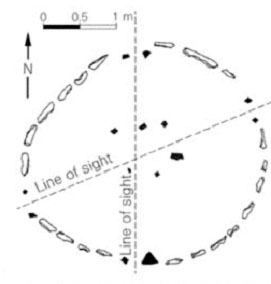|
Location:
100KM West of Abu Simbel,
Egypt. |
Grid Reference:
22� 32' 00"
N,
30� 42' 00" E. |

 Nabta Playa:
(Stone Circle).
Nabta Playa:
(Stone Circle).
The stone circle at Nabta is special in several ways. Firstly, it
is the only megalithic circle in Egypt, but perhaps more importantly,
it was situated on the Tropic of Cancer (presumably deliberately),
which makes it one of the first known examples of an astronomic observatory in the world.
The suns rays, on the summer solstice, strike
the ground absolutely vertically and no casts no shadow for several minutes.
Located 100 km west of Abu Simbel, in southernmost Egypt, Nabta Playa is
a large, internally drained basin, which during the early Holocene ( ca.
11,000 - 5500 calibrated radiocarbon years ago) was a large and
important ceremonial centre for prehistoric people. It was
intermittently and seasonally filled with water, which encouraged people
to come there, and today it contains dozens, and perhaps hundreds, of
archaeological sites. People came from many regions to Nabta Playa to
record astronomical events, erect alignments of megaliths, and build
impressive stone structures. (1)
In March 1998, a team led by Southern University Methodist
Anthropology Prof. Fred Wendorf announced that they had found the megalithic site. The site consists
of a stone circle, a series of flat, stone structures and five lines of
standing and toppled megaliths. Romauld Schild of the Polish Academy of
Sciences confirmed that one of the megalithic lines was orientated in an
east-west direction.
The Nabta Playa basin
has been occupied by humans since around the 10th Millenium BC
(1), There is evidence of
cattle domestication, perhaps offering the first suggestions of
the later cattle veneration seen in the early Egyptian
dynasties.

Alignments - Five
megalithic alignments at Nabta radiate outwards from a central collection of
megalithic structures. The small stone circle contains four sets
of upright slabs, two of the sets being aligned in a north-south
direction while the second pair of slabs provides a line of
sight towards the summer solstice horizon. An east-west
alignment is also present between one megalithic structure and
two stone megaliths, which stand about a mile distant.
Furthermore there are two other geometric lines involving about
a dozen additional stone monuments that lead both north-east and
south-east from the same megalith. (16).
Nabta, being on the
Tropic of Cancer, for one day only, on the summer solstice, the suns rays
strike the ground absolutely vertically and upright stones cast no shadows
for several minutes.
Article - Science Daily
1998
An assembly of huge stone
slabs found in Egypt's Sahara Desert that date from about 6,500 years to 6,000
years ago has been confirmed by scientists to be the oldest known astronomical
alignment of megaliths in the world.
Known as Nabta, the site
consists of a stone circle, a series of flat, tomb-like stone structures and
five lines of standing and toppled megaliths. Located west of the Nile River
in southern Egypt, Nabta predates Stonehenge and similar prehistoric sites
around the world by about 1,000 years, said University of Colorado at Boulder
astronomy Professor J. McKim Malville.
The Nabta site was
discovered several years ago by a team led by Southern Methodist University
anthropology Professor Fred Wendorf. A 1997 GPS satellite survey by Malville,
Wendorf, Ali A Mazar of the Egyptian Geological Survey and Romauld Schild of
the Polish Academy of Sciences confirmed one of the megalith lines was
oriented in an east-west direction.
A paper on the subject by
the four researchers will appear April 2 in the weekly British science
journal, Nature.
"This is the oldest
documented astronomical alignment of megaliths in the world," said Malville.
"A lot of effort went into the construction of a purely symbolic and
ceremonial site." The stone slabs, some of which are nine feet high, were
dragged to the site from a mile or more distant, he said.
The ruins lie on the
shoreline of an ancient lake that began filling with water about 11,000 years
ago when the African summer monsoon shifted north. It was used by nomads until
about 4,800 years ago, when the monsoon moved southwest and the area again
became "hyperarid and uninhabitable."
Five megalithic alignments
at Nabta radiate outward from a central collection of megalithic structures.
Beneath one structure was a sculptured rock resembling a cow standing upright,
Malville said. The team also excavated several cattle burials at Nabta,
including an articulated skeleton buried in a roofed, clay-lined chamber.
Neolithic herders that began
coming to Nabta about 10,000 years ago -- probably from central Africa -- used
cattle in their rituals just as the African Massai do today, he said. No human
remains have yet been found at Nabta.
The 12-foot-in-diameter
stone circle contains four sets of upright slabs. Two sets were aligned in a
north-south direction while the second pair of slabs provides a line of sight
toward the summer solstice horizon.
Because of Nabta's proximity
to the Tropic of Cancer, the noon sun is at its zenith about three weeks
before and three weeks after the summer solstice, preventing upright objects
from casting shadows. "These vertical sighting stones in the circle correspond
to the zenith sun during the summer solstice," said Malville, an
archaeoastronomer. "For many cultures in the tropics, the zenith sun has been a
major event for millennia."
An east-west alignment also
is present between one megalithic structure and two stone megaliths about a
mile distant. There also are two other geometric lines involving about a dozen
additional stone monuments that lead both north-east and south-east from the
same megalith. "We still don't understand the significance of these lines," Malville said.
During summer and fall, the
individual stone monoliths would have been partially submerged in the lake and
may have been ritual markers for the onset of the rainy season. "The
organization of these objects suggest a symbolic geometry that integrated
death, water and the sun," Malville said.
Although some believe the
"high culture" of subsequent Egyptian dynasties was borrowed from Mesopotamia
and Syria, Malville and others believe the complex and symbolic Nabta culture
may have stimulated the growth of the society that eventually constructed the
first pyramids along the Nile about 4,500 years ago.
"The Nabta culture may have
been a trigger for the development of social complexity in Egypt that later
led to the Pharaonic dynasty," he said. The Nabta project was funded primarily
by the National Science Foundation. The site also contains a
wealth of cultural debris, including small, fire-blackened stones from ancient
hearths built along the ancient lakeshore as well as manos, metates and carved
and decorated ostrich eggshells.
(Ref:
Science Daily: Apr, 1998)
(Egyptian
Astronomy)
(Other Egyptian Sites) (Stone
Circles Homepage) (Archaeoastronomy
Homepage)
|